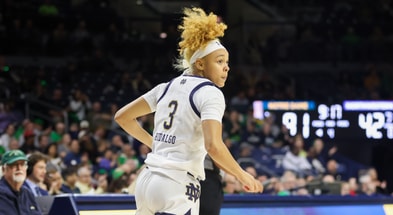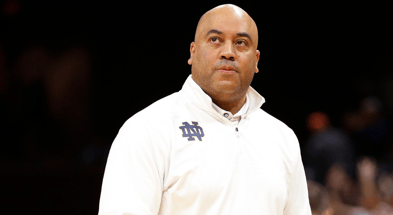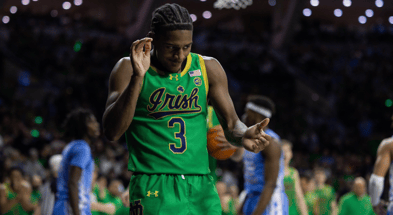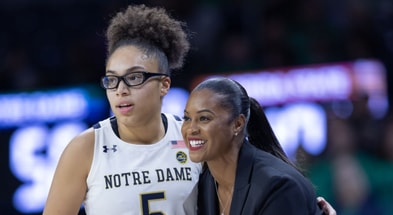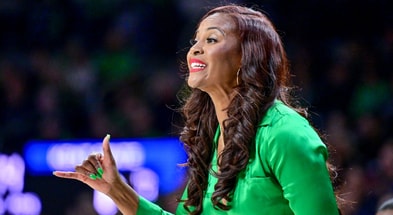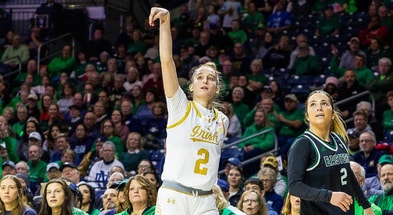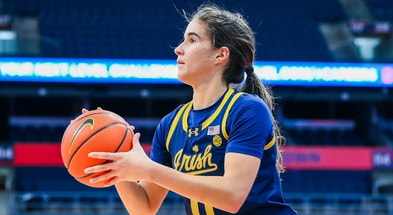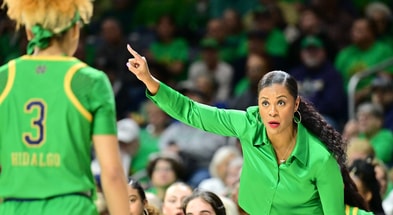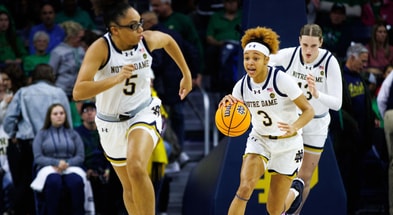Observations: Notre Dame sputters down stretch in loss to Florida State
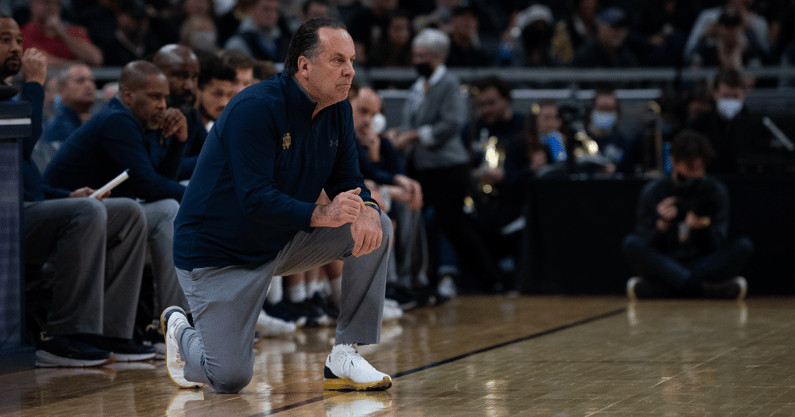
Notre Dame must wait a few more days to lock up its ACC Tournament seed and potentially set the team record for most conference wins in a season.
The Irish could have done both Wednesday by beating Florida State on the road. Instead, the Irish lost to the Seminoles 74-70, falling to 21-9 overall and 14-5 in the ACC. They shot 43.5 percent from the field, 26.3 percent on three-pointers and scored 26 second-half points. Freshman guard Blake Wesley scored a team-high 21 points.
Florida State (16-13, 9-10 ACC) shot 41.2 percent overall.
Here are three observations from the game.
1. Role reversal and offense sputters
Notre Dame has consistently closed out opponents because it makes three-pointers and allows a low volume of them. The Irish found themselves on the other side of their own strategy Wednesday.
Florida State pulled ahead in the second half with a 4-of-7 start from three-point range and finished 12 of 29 overall. Two barrages at the start of both halves kept the Seminoles in the game for 40 minutes. Both were a break in character for a team that ranks outside the top 200 in three-point volume, per KenPom.
“It’s a little bit like, ‘We have nothing to lose. We’re just going to fire,’” head coach Mike Brey said. “You could feel it coming when they made the first two. ‘Here we go, we’re going to have to absorb this.’”
PROMOTION: Sign up for just $1 for first year at Blue & Gold
Florida State also stiff-armed a Notre Dame comeback by not giving up clean perimeter looks.
The Irish missed all 10 three-pointers they took in the second half and were 5 of 19 overall. They attempted just 27.5 percent of their shots from beyond the arc, well below their usual 43.8 percent figure. They had just two assists in the second half. Their half-court sets featured less flow and more settling for contested jumpers than normal.
“You can’t run any of your ball reversal against this switching,” Brey said. “You’re going to have to make some plays. I thought we did that, especially in the first half. But you have to make a few more.”
Notre Dame attacked Florida State’s switching off the dribble and found its way to the rim, but was 19 of 42 on them. Florida State’s size and length often put a wall around the basket, especially when its interior defenders hunted blocks and altered shots.
The Seminoles’ help defense at the rim, though, opened the offensive glass. Notre Dame rebounded 12 of its 39 first half misses — a rate nearly 10 percent higher than its season average — and scored 19 second-chance points. There were windows for kick-outs from the paint, but those passes weren’t made often enough.
2. Pushing the pace
A byproduct of Notre Dame’s less rigid offense in recent weeks is Brey encouraging his guards to push the pace. Wesley and senior guard Prentiss Hubb heard him loud and clear and sought transition run-outs all game. Hubb made an early coast-to-coast layup after a Florida State basket. He found Wesley for a fast-break layup after scooping a loose ball. Senior guard Cormac Ryan hit graduate student forward Paul Atkinson Jr. for layup in transition. The latter was a willing rim-runner all night.
Top 10
- 1Breaking
Deion Sanders violations
Coach Prime caught by NCAA
- 2
Pat Coogan
Notre Dame center entering Transfer Portal
- 3New
Top 25 QBs in CFB
Looking ahead to 2025 season
- 4
2025 Heisman Odds
The early front-runners are in
- 5Trending
Bill Belichick signs
UNC coach inks deal
Get the On3 Top 10 to your inbox every morning
By clicking "Subscribe to Newsletter", I agree to On3's Privacy Notice, Terms, and use of my personal information described therein.
Not all fast-break attempts were successful, but the frequency stood out for a team that began Wednesday ranked 271st in tempo, per KenPom. This was a 68-possession game. Notre Dame came in averaging just less than 66 possessions.
Two unsuccessful ones in the second half that stood out were a pair of outlet passes that led to open wing threes for senior guard Dane Goodwin, a 45.6 percent shooter, who missed both. On the other side, Notre Dame’s only two assists of the second half were transition passes from Ryan to Atkinson for layups.
3. Résumé implications
Notre Dame fell to 5-8 in the first two quadrants with the loss, which stands as a Quadrant 2 defeat. On a micro level, this one shouldn’t stain the tournament résumé much. It’s a Quadrant 2 road game. The Irish’s road record remains a sturdy 7-5.
Overall, though, a sub-.500 record in the first two quadrants and computer numbers in the low 40s and high 50s will put a ceiling on the seed outlook. The Irish’s best case is finishing .500 against the first two quadrants. (Saturday vs. Pitt is a Quadrant 4 and they will play a maximum of three ACC Tournament games).
As of Wednesday morning, there were 11 other at-large teams in BracketMatrix.com’s projected field with losing records against the first two quadrants. It’s not a disqualifier. The only three that weren’t double-digit seeds, though, have at least five Quadrant 1 wins. Notre Dame has two. Every team that is at least three games under .500 against Quad 1 and 2 is a No. 10 seed at best.
This isn’t to suggest real danger of missing the field. Only a loss to Pitt should invite worry. But if the Irish end up as a No. 10 or 11 seed, a middling record against the first two quadrants will likely be the reason. Maybe that’s not entirely a bad thing. The theory that it’s better to be a No. 10 than a No. 8 or 9 seed to avoid a No. 1 in the second round persists for a reason.


